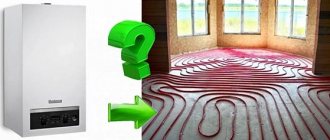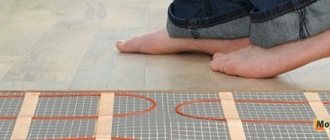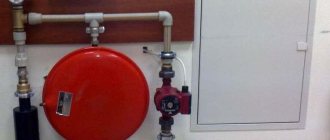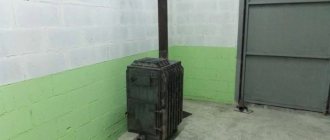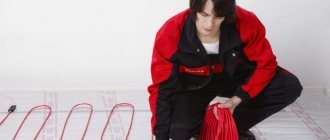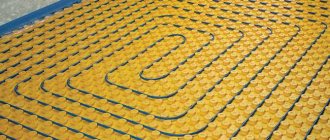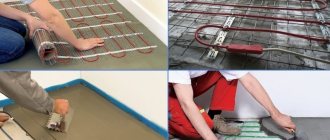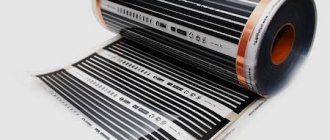Hello readers of my blog! Today we will talk about how to properly install an electric boiler for a heated floor with your own hands. It would seem that the matter is not tricky, but when you are faced with this problem, you have to think about how to do it correctly, what preparation to do, what materials to choose. Thus, I decided that this article would be useful to someone, and I am devoting my efforts to this subject. In it I will answer a number of questions that will arise immediately before How to properly install an electric boiler for a heated floor with your own hands, and some even after that. This topic is quite broad, because before work, thorough preparation is necessary, but how to do this? And this is a separate topic. You can learn about all this in great detail in the article below.
Safety regulations
Before we move on to the main part of heating installation, I would like to pay attention to the safety of electrical installation work.
Firstly, the connection of the electric heating boiler must be carried out when the electricity is turned off.
Secondly, it must be installed at a certain distance from other objects, namely:
Thirdly, the network must be three-phase (380 V) in order to reduce the current load on the electrical wiring. When using a single-phase network to connect a powerful boiler, the wiring may not be able to withstand it, resulting in spontaneous combustion and a short circuit.
Fourthly, all wire connections must be sealed and protected from water.
Water ingress onto the contacts can occur when the pipeline is damaged (for example, the coupling connected to the unit bursts) and when condensation drains from the ceiling (in an unheated room).
It is also recommended to protect the cable with corrugation or a cable duct made of self-extinguishing material. If the wires catch fire, these products will prevent the spread of flame.
Top manufacturers
There are many European and Russian companies that produce boilers that can be installed in heated floors. We will tell you about the most famous ones that produce high quality products.
Buderus Logamax
A German company produces environmentally friendly wall-mounted heating elements of various capacities.
Pros of Buderus Logamax:
- can be connected to any type of heating;
- installation in closed systems is available;
- have increased efficiency;
- not difficult installation.
Among the disadvantages is the high price.
Kospel EKCO
A Polish company produces wall-mounted heating equipment that can be connected to heated floors. Equipped with a power regulator with 6 adjustment levels and an automatic switch.
The process of installation and operation of these devices is simple. But such electrical equipment is expensive.
“Galan”, series “Hearth”, “Geyser”, “Vulcan”
Reliable electric boilers from a Russian manufacturer, with a warranty period of 30 years. They are easily optimized for any level of heat loss and have a quick payback.
The equipment is flow-through, so its installation does not need to be coordinated with supervisory services. Water is heated without heating element, by ionization.
The advantages include:
- automation;
- prostate mounting,
- silent operation;
- low cost.
Among the disadvantages:
- afraid of sudden power surges;
- there is a large load on the wiring.
Ferroli
An Italian company that produces a huge range of wall-mounted single-circuit electric boilers of different capacities, which are connected to a single- and three-phase network.
High-quality electric boilers with weather-compensating function. They have a digital control panel in the form of an LCD display.
Disadvantages: high cost and lack of a sensor to maintain a constant temperature.
RusNIT
The company (Russia) produces small and lightweight electric boilers mounted on the wall, capable of heating a room of up to 80 m2. They operate from single-phase and three-phase networks.
The company's pricing policy is affordable for most consumers. It is worth noting the difficulty of installation, which sometimes arises during connection for untrained people.
Baxi Amptec
Baxi (Italy) - manufactured devices are suitable for different heating systems - radiators or floor heating. A number of models can operate at low temperatures.
The devices are compact in size and easy to operate. Their price is directly related to the power of the unit.
The advantage is that they work outdoors at sub-zero temperatures.
Installing the unit
First you need to install an electric boiler indoors. As we have already said, the unit can be floor-mounted or wall-mounted. In the first case, the kit includes a special stand, on which the “landing” is performed.
In order to hang the boiler on the wall, you need to prepare anchors with dowels and a drill with a suitable drill bit. First, mark the wall using a tape measure and a marker.
The holes must be placed perfectly level in a horizontal plane. Next, we drill out the marked places, drive dowels into them and screw in the anchors. After the anchor is firmly seated inside the wall, you can hang the electric boiler.
We draw your attention to the fact that the installation of the electric boiler must be carried out perfectly level in both horizontal and vertical planes.
Any misalignment can affect the performance and service life of the equipment.
Degree of autonomy
Requirements for the comfort of heating equipment are not the whims of spoiled consumers: not everyone has the opportunity to constantly monitor the operation of the heating system and add fuel. That’s why we consider this parameter first.
Electric boilers have the highest degree of autonomy. There is electricity - they work without human intervention. Moreover, after a power failure, they start working independently; many of them have “memory” and save settings. But there are three types of electric colas:
An electric boiler for underfloor heating with heating elements is a traditional solution. They just have one “disease” - heaters burn, and quite often. But their cost is average, and the technologies have been tested and proven; even a person who is not very good at communicating with technology can replace a burnt-out heating element. In general, a good (but not the best) option.
Electrode boilers for heated floors are so miniature that you won’t immediately notice them in the piping
One of the new products is electrode boilers. They are less inertial than heating elements, but are capricious in operation. In the sense that they impose quite stringent requirements on the quality of the coolant. It’s just that their work is based on the conductivity of the coolant, hence such features. The principle of their operation is as follows: two electrodes are lowered into the liquid, to which an alternating voltage of 50 Hz is applied. The particles located between the electrodes, depending on the polarity, begin to move towards one of the electrodes, releasing a significant amount of heat during movement. Since the polarity changes at a frequency of 50 times per second, the movement of ions is continuous. Therefore, the coolant heats up quickly. These units cannot burn in principle: there is no coolant, no heating. So from this point of view everything is fine. But maintenance is still required: the electrodes need to be changed periodically, and when starting the system, you will either have to fill in a ready-made liquid (sales of heating equipment have it), or prepare drinking water according to the rules (add salt once a season according to the norm). So electrode boilers for heated floors are a good option.
One of the types of electric boilers is an induction boiler. Takes up very little space and is easy to install, can operate in low temperature mode
Another type of electric units that can be used for floor heating are induction models. Their work is based on the fact that a conductor placed in a magnetic field heats up. In induction boilers, the housing acts as a core; an inductance coil is wound around it according to certain rules. The body is made in the form of a thick-walled labyrinth. Water flowing through the labyrinth cools it. This type of heating equipment is reliable in operation. It can only burn if there is no movement of the coolant or the coolant itself: the housing quickly overheats and can melt. But such cases are very rare. This is rather a theoretical possibility. An induction boiler is good for everyone: the warm floor will heat up quickly, and there will be energy savings, but such equipment costs significantly more than heating elements units.
Another general advantage of using any electric heaters is that they do not require chimneys; for many, the environmental friendliness of such heating is also important.
Second and third places in terms of autonomy are shared by pellet and gas boilers. But here we need to make a reservation that gas units must be electronically controlled. Many consider automated control to be a disadvantage: after all, if there is no electricity, then there is no heat. But in the case of a water heated floor, this is irrelevant: without a pump it will still not work. But the automation itself regulates and adjusts the temperature, controls the system parameters and its safety. And to reduce dependence on the availability of electricity, you can create a redundant power supply. To ensure the operation of the boiler and circulation pump for several hours, it is enough to install an uninterruptible power supply and a couple of car batteries. If you need a “safety margin” for a couple of days, then you will need a diesel generator.
This is how a wall-mounted unit is connected to a water-heated floor system
Why second and third place? Because in addition to the presence of electricity, fuel is also necessary for operation: gas boilers operate as long as there is acceptable pressure in the main line, and pellet boilers - as long as there are pellets in the bunker. The bunker can be as large as desired. There is room - fill up at least a month's supply, at least for the whole season. All maintenance of a pellet boiler comes down to removing ash once a month; automated gas boilers do not require any maintenance at all - if only there was gas and electricity, and normal draft.
In penultimate place are heaters operating on liquid fuel. They require fairly frequent checking, and all because the quality of our diesel fuel is not the best. In addition, at a temperature of +5 o C this fuel begins to thicken and clog the injector. Dealing with clogged filters and solving the heating issue are two concerns that await you when using diesel boilers.
The most “independent” are solid fuel installations. You need to add fuel to them often, regularly remove ash and slag, and regulate the intensity of combustion. There are, of course, pyrolysis technologies and long-burning boilers. The best models can work on one bed of coal for several days (up to 7 days for some models from Stropuva). But there are also difficulties here: they are demanding on fuel (you need dry firewood or coal of a certain standard), and the price can also be a deterrent.
A solid fuel boiler for water heated floors requires constant human presence. Pyrolysis units and long-term combustion units require “refueling” two to three times less often
You can use a regular solid fuel boiler for a water heated floor, but you will have to spend a lot of time near the stove. Although there are already solid fuel units with automated supply. They are equipped with pellet-type bunkers and a screw feed. Only the requirements for the size and quality of fuel in them are no less stringent than those that run on pellets. But you can leave your home for a few days and not be afraid that the system will expand.
There is another option - combined solid fuel boilers. These are units in which a heating element is built-in. It turns on after the fuel supply has burned out and the coolant has cooled to a certain temperature (you set it). Electric heating cannot produce the full power of the unit, but it will maintain the temperature, and your floor will remain warm even after extinguishing.
We connect the electrical wiring
Since an electric water heater has more power, it is necessary to connect it not from an outlet, but directly from the mains. To do this, a separate line must be drawn from the distribution box in the room, going to the boiler connection point.
It is better to use a hidden cable route, since in this case the line will be protected from mechanical damage and the appearance of the room will not deteriorate.
It should be noted that to power the boiler it is necessary to use a large cross-section cable that can withstand fairly high current loads. We talked about how to correctly calculate the cable cross-section in the corresponding article, which we strongly recommend that you read.
So we draw your attention to the fact that small-power water heaters (up to 7 kW) can be connected to a single-phase network, which is often found in Khrushchev-era buildings and old-style apartments.
Well, the last nuance at this stage that you should know about is that electric boilers up to 3.5 kW can operate from an outlet, and not from a separate line from the distribution box. Low-power boilers are ideal for connection in an apartment, because in this case the electrical wiring is usually single-phase and making new cable wiring is not always a practical solution.
System and stages of installation of a warm water floor
The technology for concrete screed is the simplest. The first thing to do is to clean the floor of old floor coverings and cement all cracks and potholes.
Any work begins with drawing up a plan and preparing the workplace
Thermal water floor installation system:
- Cleaning and leveling the subfloor;
- Waterproofing;
- Installation of edge insulation around the perimeter of the room;
- Thermal insulation;
- Reinforcement;
- Installation of heating pipes;
- Connecting heating pipes to the boiler;
- Trial;
- Pouring the floor with concrete or cement screed;
- Break – 1 month;
- Sound insulation device;
- Decorative flooring.
It is also necessary to check the floor level; if the difference is up to 1 cm, then you can ignore it, but if the difference is more than 2 cm, then you need to level the floor with a cement screed and allow the surface to dry for at least 2 weeks. Next, you need to waterproof the floor in case of hot water leakage from the pipes
Along the perimeter of the room, apply edge insulation with damper tape to the height of the proposed floor. Thermal insulation is the next stage of action. The insulation must be laid throughout the room; the minimum thickness of the insulation is about 2–5 cm. Next, reinforcement should be carried out over the entire surface of the room. To do this, you need a purchased reinforcing mesh with cells of 16–21 cm. It is to this mesh that the heating pipes will be attached, because they bend perfectly. The pipe routing is secured using special plastic ties or clips (track).
We install protective equipment
When all the input wires are connected to the electric boiler, it will be necessary to additionally protect it with RCD circuit breakers installed in the main panel.
The purpose of the first device is to protect equipment from short circuits and wiring overloads. Connecting an electric boiler through an RCD will protect you from leakage currents.
It is also recommended to connect a voltage stabilizer, since even small surges can damage the unit. I don’t think it’s worth talking about the need to ground an electric boiler. The main requirement is that the ground wire runs directly from the bus to the equipment frame.
We are launching
When all wiring elements are connected, it is necessary to check all connection points. There should be no exposed contacts, as well as damaged insulation.
It is also necessary to check all couplings, taps and pipe joints. Only after a high-quality inspection of the heating system can you proceed to its start-up. First, we open the valves connected to the equipment, and then turn on the electric boiler.
Pay attention to the functionality of the temperature and pressure sensors. The nominal values are indicated in the instructions included in the kit. In case of obvious deviations, it is better to call a specialist.
What can you save on?
Electric heating is quite expensive compared to gas heating. To make it economical, it is recommended to consider the following tips:
Buy a two-tariff electricity meter and turn on the heating at night. During the day, as a rule, everyone is at work and there is no need for the boiler to operate. It is better to properly heat the room at night, because at this time the price for 1 kW of electricity will be much lower.
Use automation that will allow you to turn on the heating at a certain time or only when the temperature drops by a set value.
In this case, the unit will operate only when absolutely necessary. The highest heating of radiators is achieved by placing the boiler at the lowest point of the heating system. Add a modern solution to your heating system - heated floors, it will allow you to more efficiently use the heat consumed throughout the room.
We return to the use of two-tariff meters. Another option for their rational use for heating is to buy heat accumulators. These containers of water can heat the room throughout the day, while the liquid will heat up at night (when electricity will cost much less).
That's all I wanted to tell you about installing and connecting an electric heating boiler with your own hands.
Finally, we recommend that you buy devices only from high-quality manufacturers so that the heating in your home lasts as long as possible.
Among the leaders in the production of water heaters, there are three that are the most optimal in terms of price and quality: Protherm, Nevsky (we looked at its connection in the video) and Galan.
Correct installation of an electric boiler
There are several types of heating equipment, one of which is electric heating boilers. These devices have their own classification and a number of features that require detailed consideration.
How to calculate power indicator and heating costs
The power of an electric boiler can be calculated using the formula:
M = K x OP x RT x KR x 1 kW/860 kcal,
Where:
- K is the safety factor, it is equal to 1.15 or 1.2;
- OP - room area;
- RT - temperature difference between room and outdoor;
- KR - dissipation coefficient.
The standard standard for the thermal power of an electric boiler for a hydrofloor is 1 kW per 10 m2. If a double-circuit is mounted, then another 30% is added to this figure.
The peculiarity of the unit is that when hot DHW is turned on, heating of the liquid continues, and this is an additional load. Therefore, the technical documentation indicates which cable parameters are recommended for this type of heating.
Often, when calculating power, the figure is 5.2 or 8.2 kW, then the value is rounded up.
Types of electric boilers
The following types of electric heating boilers are available on the market:
- Heating elements. The heating element of such devices are tubular electrical elements.
- They are installed in the heat exchanger tank and ensure the operation of the boiler.
- Electrode. In this case, heating is carried out by supplying current to the water. Heating is possible due to the fact that water contains a certain amount of salts that allow electricity to pass through.
- When electricity is supplied, water particles move and heat up, providing heat transfer.
- Induction. In such devices, the heat exchanger is a ferromagnetic rod installed in a dielectric tube. When current passes through an inductor wound around a pipe, eddy currents arise, which generate heat.
In addition to boilers, you can find electric radiators on sale. Structurally, such devices are ordinary sectional batteries, each of which has its own heating element built into it. To create complete heating for your home, you will need several such devices - installing an electric heating boiler in a private house is good because its power initially covers all requirements, unlike radiators.
Induction
The operation of induction models is based on the physical phenomenon of “induction”, which occurs in interacting coils. They rightfully occupy leading positions in the markets.
If we talk about the advantages, it should be noted:
- Very high efficiency, reaching 99% - thus all the electricity you have to pay for is converted into heat
- Economical and effective when interacting with underfloor heating systems
- Can be simultaneously used for domestic hot water supply (hot water supply)
The only drawback may be the cost of such equipment. It is easy to install, but if it breaks, it requires repair by a professional technician.
Features of electric heating equipment
There is a widespread belief that all types of electric heaters provide savings of about 30-40%, and installation of an electric heating boiler will be as profitable as possible. The values described are large, and in theory they allow you to save a significant amount on heating.
As a rule, the reason for such efficiency is given as reduced power - that is, when calculating the heating system, it must be assumed that heating one square meter of room requires about 60 W of energy instead of the required 100 W.
Everything said in the previous paragraph is the erroneous opinion of most users. It is not advisable to compare direct heating devices in terms of efficiency, since they will all be equal. This statement is based on the law of conservation of energy, according to which energy cannot appear out of the blue and disappear into nowhere.
In relation to electric heating devices, this means that all generated energy will be converted into heat.
Of course, this phenomenon will be accompanied by certain losses - nevertheless, part of the heat will certainly dissipate in the air and will not be transferred to the coolant. But the volume of losses directly depends on the insulation of the device body, and not on the type of heating equipment. In addition, the heat released outside will directly warm the room where the boiler is installed.
If we look at the problem from the other side, then heating is designed to compensate for heat losses, the amount of which is determined by:
To summarize, we can definitely say that the type of heat source has no relationship with the thermal power required to heat the building - which means that the vaunted efficiency of electrical devices is simply absent.
However, this only applies to efficiency - each electrical device has special performance qualities:
Electric radiators.
Such devices load the electrical network evenly, so there are no wiring requirements.
Induction boilers. Such heating equipment is compact and reliable. The latter quality is due to the fact that there is no heating element in the heat exchanger, and the power controller and coil are located outside, so water does not have any effect on them.
In addition, induction boilers can work with any coolant.
Electrode boilers. Differ in smallest sizes. Such boilers require constant replacement of electrodes, since they dissolve in water over time.
Only water containing a certain amount of salts can be used as a coolant.
Heating element boilers. The main problem of boilers with heating elements is the constant deposition of scale on the heating elements (this factor is irrelevant for closed heating circuits, in which the amount of salts is initially limited). In addition, these devices are quite large in size.
Saving
Options for saving energy, in addition to choosing more economical models and types of heater, are based on the use of thermal inertia of the coolant. For example, if there is a concrete screed, it becomes possible to periodically disconnect the heater from the network.
The concrete layer takes a long time to cool, which allows you to significantly save energy (and money) - up to 30%, and sometimes more. In addition, it would be rational to organize the correct distribution of operating modes of the circuits in different rooms - cooler in the corridors, warmer in the living room or bathroom. This separation will help reduce the heating intensity and save money.
Electric boiler wiring
The piping of electric heating boilers should include the following elements:
- Circulation pump.
This piping element ensures the movement of coolant along the heating circuit, thereby ensuring heat transfer to heating devices.
- Expansion tank.
The key purpose of the expansion tank is to receive excess coolant when it overheats excessively. The absence of a tank can lead to rupture of pipes or damage to elements of the heating system.
- Safety valve.
Using a safety valve, excess coolant is discharged into the sewer.
The valve only works in emergency situations - for example, when water boils when the pump stops or when the tank overflows. The pressure at which the valve operates is usually equal to the maximum pressure in the system.
- Automatic air vent.
This element ensures independent removal of air from the heating system circuit.
In the absence of an air vent, coolant circulation will be difficult, and the system itself will make a lot of noise. Pressure gauge. The presence of a pressure gauge makes it possible to monitor the pressure level in the heating system pipeline. The pressure gauge scale must be designed for at least 4 bar.
The expansion tank, air vent and safety valve are a safety group of the heating boiler. The installation of an electric boiler in a private house must be accompanied by the installation of a security group.
Prefabricated manifold systems
A complete manifold system, along with shut-off valves and temperature regulators, includes:
- mixing unit;
- drain tap;
- air exhaust;
- a pump that circulates liquid in pipes.
An analogue to a shut-off valve at the inputs/outputs can easily be a valve with a control thermostat. The main advantage of these devices is their ability to contract and expand depending on the set optimal temperature, setting the intensity of the flow of heated liquid.
The mixer pump must be installed between the supply clamp and the supply pipe, while the third outlet goes to the return and is located in front of the return clamp. The resulting connection will allow the pump to take cooled liquid from the system and transfer it directly to the supply.
Selecting a circulation pump
For a circulation pump, two parameters are important - pressure and performance. The amount of pressure in most cases is practically irrelevant.
The minimum pressure for the weakest pumps is 2 meters, which is quite enough to ensure normal operation of the heating system of any private home:
Selecting an expansion tank for installation
For closed heating systems, membrane tanks are usually used, in which the compensating cavity is filled with air or gas. Between the cavities of the tank there is a flexible membrane. When the temperature of the coolant increases, its excess enters the tank and compresses the membrane.
To determine the volume of the tank, you can use a simple calculation. First you need to measure the total volume of coolant in the system, for which it is enough to drain it into any container whose volume is known. 10% is taken from this value - and this is the value the tank volume should have.
Boiler piping location
Each strapping element must be installed in a strictly defined location:
In boilers with heating elements, all piping elements are often mounted in the equipment itself, i.e. it turns out a smaller copy of a full-fledged boiler room.
Do-it-yourself installation of an electric boiler with heating radiators is usually carried out in a circuit break using two ball valves, which allow, if necessary, to turn off the boiler without draining all the coolant.
Pipes for electric boilers
The issue of choosing heating pipes is quite important and always requires a lot of effort. However, installing an electric boiler in a private house does not impose any special requirements on pipes - it is quite possible to use the same metal, plastic and metal-plastic pipes that are used to install any heating systems.
The perfect solution
The most convenient electric boiler for underfloor heating is a single-circuit one. Here the operating scheme is clear and transparent: the device heats water through heating elements, the circulation pump creates pressure on the hydraulic distribution grid of the heating network, and the temperature of the liquid in the structure can be adjusted.
For rationally thinking owners, it is recommended to create separate water treatment and heating systems in the house; for the latter, using your own single-circuit boiler looks optimal.
The use of indirect heating boilers is a convenient solution for those who want to get a controlled, efficient heating system and hot water without complicating the electrical network of a house or apartment. A single-circuit electric boiler is capable of supplying water not directly to the heated floor, but through the heat exchanger of the water heater.
The operation of an indirect heating boiler is stable, therefore, in a system that has entered a stable mode, it is impossible for a situation to arise when hot water consumption sharply reduces room heating performance.
Electric boiler from a boiler
Heating devices
If the installation of an electric boiler has virtually no effect on the efficiency of the heating system, then the same cannot be said about heating devices - heat transfer directly depends on the choice of these elements. The most effective design that works great in combination with electric boilers is underfloor heating.
Structurally, heated floors are tubular heat exchangers located under the floor covering or screed. During operation, they release energy to the entire floor surface, thereby ensuring uniform heat distribution.
Using heated floors provides several advantages:
Warm floors are one of the most comfortable heating systems. The thing is that first of all, heat is transferred to the floor, so it becomes warm to the touch, and you can happily walk on it without shoes.
With increasing altitude, the temperature decreases, due to which the most comfortable temperature regime for the human body is formed.
The use of heated floors allows you to reduce the average temperature in the room. Classic convection heating assumes that to maintain a temperature of 20 degrees, you need to heat the air under the ceiling to 30 degrees. As a result, the average temperature will be about 25 degrees.
In the case of heated floors, to maintain 20 degrees, you can warm the floor to 22 degrees. The temperature under the ceiling in this case will be about 18 degrees, and the average value will remain at the proper level. Due to this phenomenon, it is also possible to reduce heat loss, since the temperature difference in the house and outside decreases.
To do without coolant, you can install a heating system from cable or film heated floors. Such designs allow you to maintain a stable temperature regardless of external factors.
Scheme of proper installation of a warm water floor
There is one rule for all pipe laying schemes - installation of pipes must begin from the walls and move towards the center of the room, and then lead the pipes to the exit of the room. The layout of heating pipes is very important for saving heat.
The advantage of a snake is its ease of installation. The pipe is laid, sequentially moving in a zigzag from one wall to the opposite
Laying schemes:
- Snake;
- Snail;
- Combined installation.
It is necessary to consider all 3 heating installation schemes. Snake - pipes run along the perimeter of the room near the walls, and then from one of the walls (this will most likely be an internal, warmer wall) returns back in a wave.
Snail - pipes follow the perimeter of the room and each circle narrows, approaching the center. This scheme will be especially applicable for rooms with 2 external walls (corner room) or a room located on the north or east side. The combined scheme combines both the first and second schemes. But in any case, it is necessary to make a detailed drawing of the layout of the pipes in the room.


